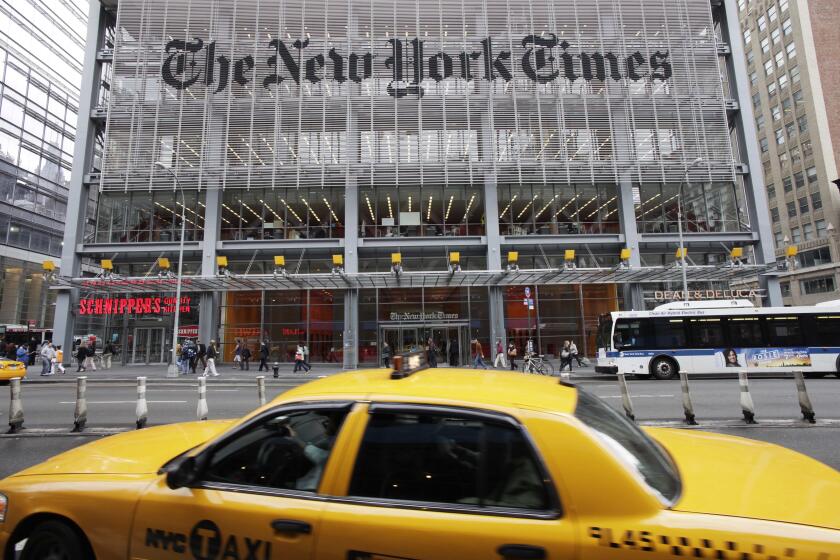New York Times journalists stage historic strike as labor tensions mount across media
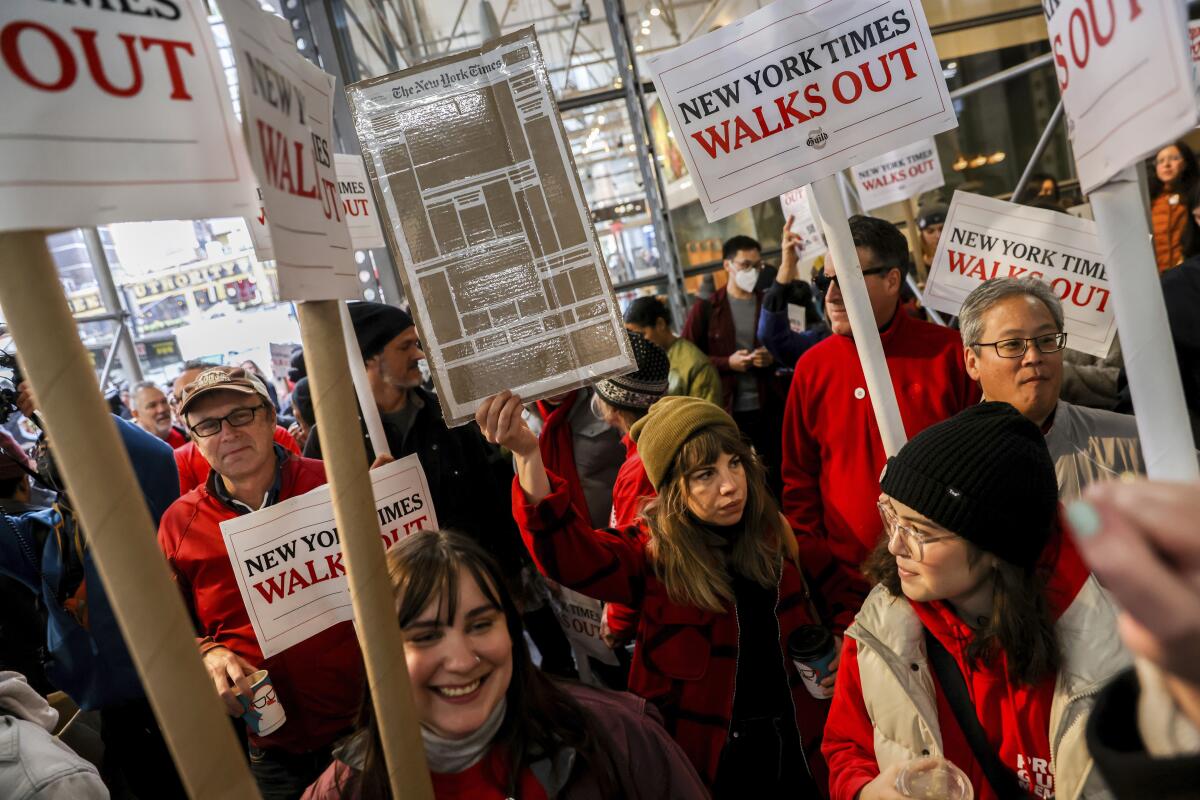
- Share via
New York — Taking a defiant stand, hundreds of New York Times journalists refused to work Thursday — the largest journalist-led labor action at the nation’s leading newspaper in more than 40 years.
The New York Times Guild’s 24-hour strike highlighted the mounting frustration of writers, editors, online producers, security guards and other staffers over the slow pace of negotiations for a new contract. The last contract expired in March 2021, and guild leaders this week said that “the company’s failure to bargain in good faith” prompted their walkout.
“We are deeply committed to the success of the paper. ... [But] today, for the first time in decades, we’re fulfilling that mission in a different way,” the newspaper’s guild and its local, the NewsGuild of New York, said in a letter to readers.
The publication’s management, however, disputed that it slow-walked a deal covering 1,450 guild members.
“It’s disappointing that they’re taking such drastic action, given the clear commitment we’ve shown to negotiate our way to a contract that provides Times journalists with substantial pay increases, market-leading benefits, and flexible working conditions,” New York Times Co. Chief Executive Meredith Kopit Levien wrote in a Wednesday night message to the staff.
Executive Editor Joseph Kahn, in a separate email to the newsroom, wrote: “Strikes typically happen when talks deadlock. That is not where we are today.”
Negotiations have been ongoing for 20 months. New York Times journalists have demanded a 10% pay bump at contract ratification (to compensate workers who went two years without a raise) and 5.5% increases in 2023 and 2024. They’ve asked for a minimum annual salary of $65,000, citing the high cost of living in New York.
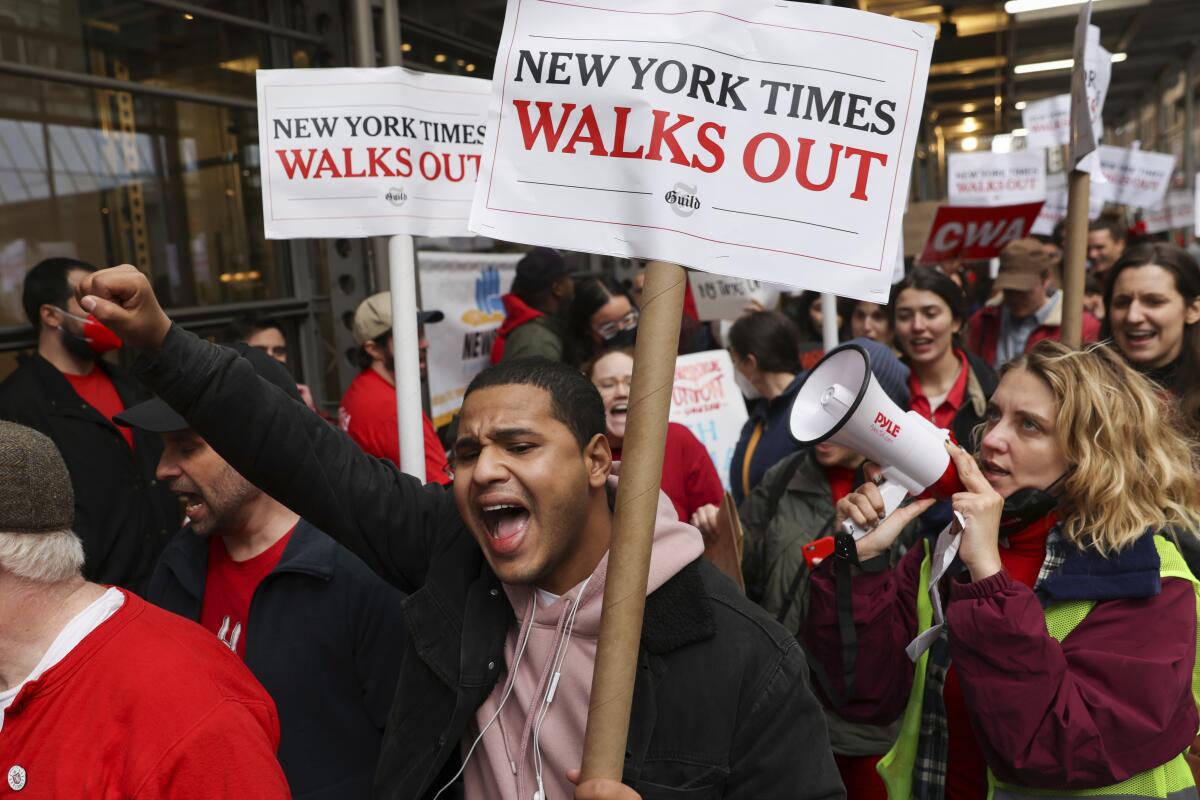
Talks have also touched on retirement and other benefits, as well as a proposal to phase out the company’s pension plan. Some journalists also want to continue to work from home as they have throughout the COVID-19 pandemic.
Tensions at the New York Times echo clashes nationwide.
Members of the Newspaper Guild of Pittsburgh are in the seventh week of a strike against the Pittsburgh Post-Gazette. The group went on strike in early October after rejecting a new employee health insurance plan imposed by management. Journalists with the Fort Worth Star-Telegram in Texas, part of a chain owned by hedge fund Chatham Asset Management, went on strike last month.
Workers at Starbucks and Amazon also have sought to form unions.
The New York Times’ union announced its intent to strike a week ago, giving managers time to stockpile stories and adjust production schedules. Press workers continued on the job, which enabled print editions to be delivered without interruption.
“We will produce a robust report on Thursday,” Kahn said in an email to staff. “But it will be harder than usual.”
The newsroom boasts more than 1,800 workers and more than 1,100 signed walk-out pledges. International reporters largely are not covered by the contract.
For the record:
7:28 p.m. Dec. 8, 2022An earlier version of this story said tech writers detailed the Federal Trade Commission’s lawsuit to block Microsoft’s planned purchase of video game company Activision. The writers wrote the story prior to Thursday in anticipation of the news.
Not all of the newspaper’s journalists participated in the walkout. Prominent Washington reporters provided in-depth coverage of the prisoner swap with Russia that freed basketball star Brittney Griner.
Susan DeCarava, president of the NewsGuild of New York, which includes the newspaper’s guild, did not have a precise number of journalists who participated. The publication declined to provide a figure. DeCarava said she received pledges that at least 80% of its members supported the action. Co-workers had sent photos from their phones of a largely empty newsroom, she said.
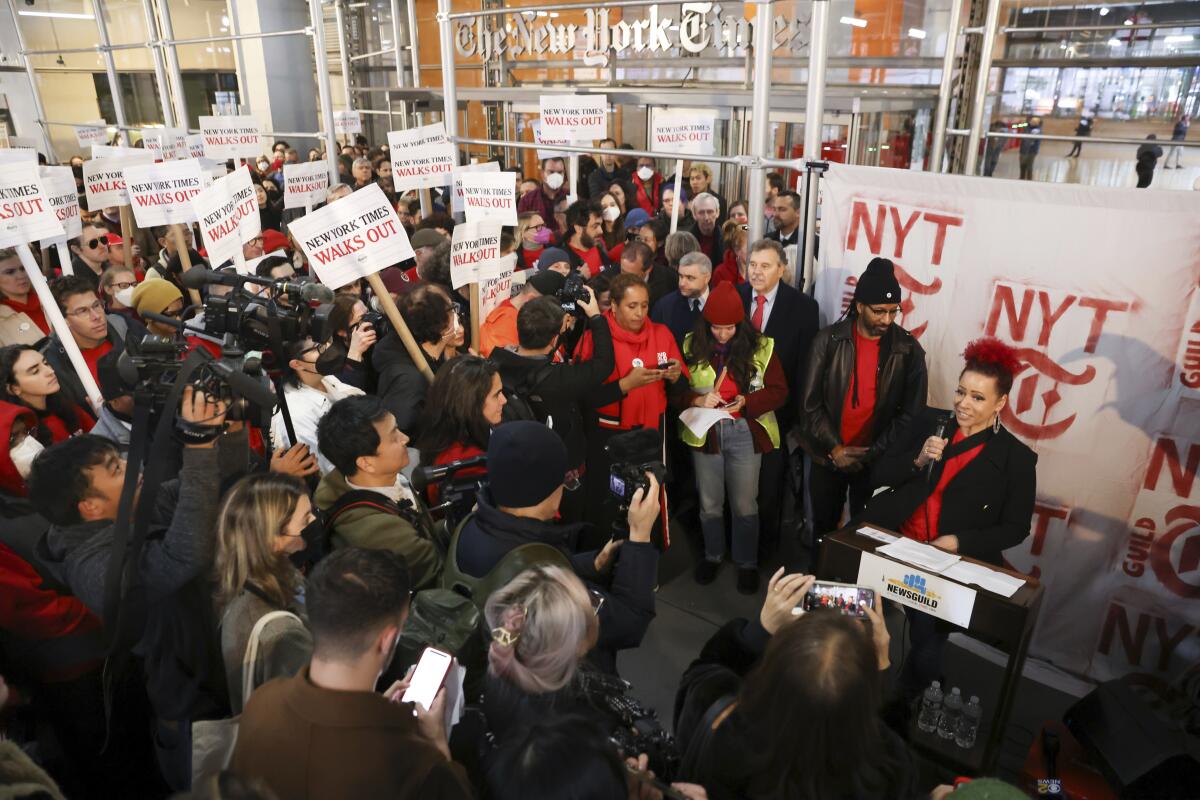
During a Thursday afternoon rally, more than 150 union members and supporters crowded in front of the publication’s headquarters at 8th Avenue and 40th Street in Manhattan.
Photographers and union members were hanging off the steel scaffolding in front of the building to get a better view. A giant inflatable snarling rat — a mascot at union job actions in New York and other cities — stood alongside the speaker lectern. Its name: Scabby.
Nikole Hannah-Jones, author of “The 1619 Project” and one of the nation’s journalism stars, spoke.
“I was a worker who couldn’t afford to pay my bills off a newspaper salary,” Hannah-Jones said in an interview. “I know how hard it is for so many of my co-workers here who may be intimidated to speak out. So it was important for me to show solidarity and to argue on behalf of my colleagues.”
After nearly an hour of remarks, employees marched with signs and were led in solidarity chants by a small drum corps.
The last significant work stoppage by New York Times journalists was a 24-day strike in 1965. There was an 88-day walkout by pressmen in 1978. Three years later, the newsroom guild struck for about six hours.
The Los Angeles Times and the L.A. Times Guild, which represents about 475 journalists, have tentatively agreed on a first-ever labor accord for the newsroom in the paper’s nearly 138-year history.
Thursday’s job action comes amid an expansion of the NewsGuild, part of the Communications Workers of America. It has been growing steadily since journalists at the Los Angeles Times voted in early 2018 to create the publication’s first newsroom union in its 140-year history.
Union activity has intensified as younger journalists step into leadership roles, unafraid to challenge their bosses over compensation and issues of work-life balance. The trend follows years of financial squeezes.
Newspapers have seen advertising revenue dramatically decline as readers migrate to Facebook, Twitter and TikTok.
The shift has created “news deserts” in many local communities, a drought that accelerated during the pandemic. Papers have withered or folded, some reducing circulation days. Journalists still working have put in longer hours and juggled more assignments to compensate for colleagues who were laid off or took buyouts.
“Low wages, hostile working conditions and a hemorrhaging industry have pushed journalists to the brink,” the Fort Worth union said in its strike announcement.
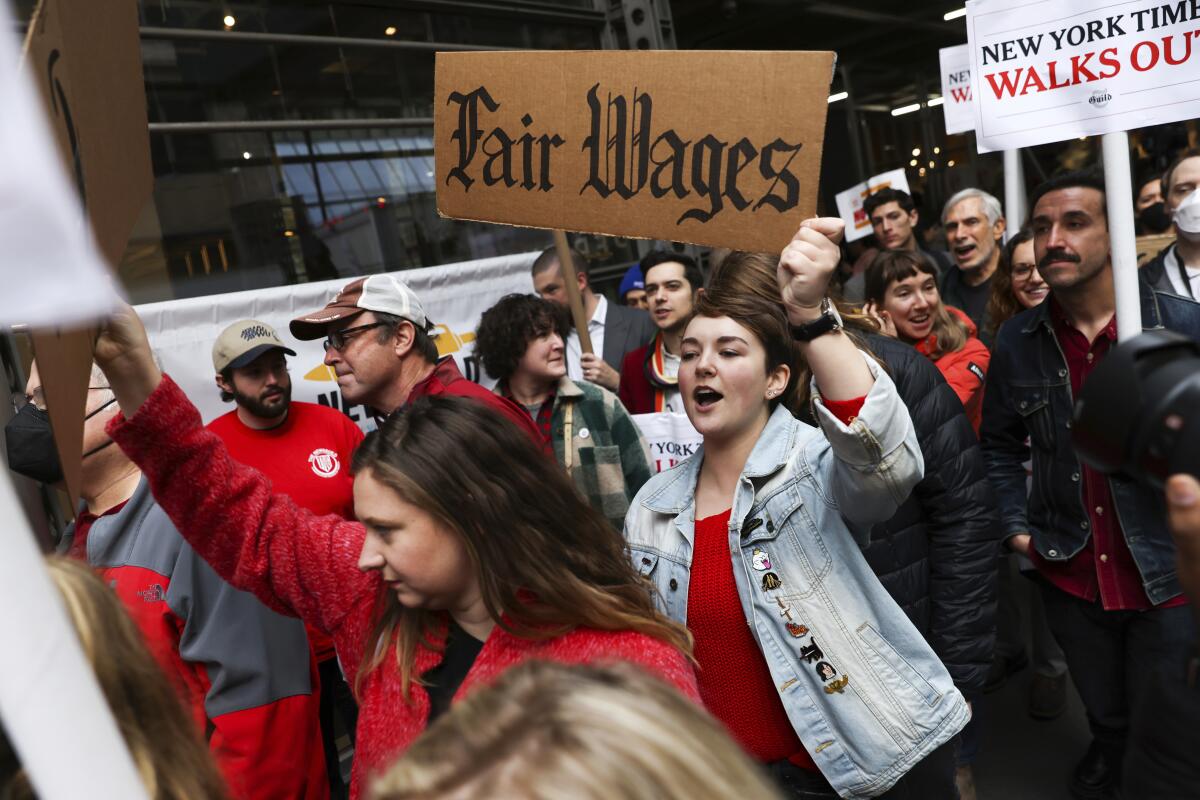
The New York Times is among the world’s most financially prosperous newspapers. It is widely viewed as the model for transitioning from a daily print edition to a vibrant online report. New York Times Co. ended the most recent fiscal quarter with more than 9 million paid subscribers and revenue gains.
It reported total revenue for the third quarter of $547.7 million, up 7.6% from the year-earlier period.
The company has been expanding. This year, it paid $550 million in cash to acquire the Athletic, the sports news site. It bought the online word puzzle Wordle. On Thursday, striking journalists called on readers to forgo their daily Wordle fix.
At the rally, speakers emphasized how New York Times Co. has touted its success to Wall Street and investors, raising its shareholder dividend and announcing a $150-million stock buyback program. Yet, the newsroom staff has gone two years without a pay increase.
The company is “on track for annual operating profit of at least $320 million,” the guild noted in its letter.
“We know what we have done for the New York Times in terms of keeping our paper afloat and making it really profitable and our top executives are getting huge amounts of compensation that have been increased by huge percentage points in the last year and they won’t give the workers in the trenches a 10 percent raise,” said Nancy Wartik, who works in the audience department at the Times.
The New York Times adds the popular daily word phenomenon to the company’s expanding portfolio of games and puzzles.
The newspaper’s Kopit Levien acknowledged the company’s success but said that 40% of revenue still comes from the print product.
“We are succeeding mightily in many ways, yet our transformation is not complete,” Kopit Levien said. “Our profits have yet to catch up to where they were a couple of decades ago. And we continue to compete fiercely in a highly dynamic digital environment for subscribers and advertisers — now against a backdrop of intensifying economic pressure and uncertainty.”
Meanwhile, the Wall Street Journal, the archrival owned by Rupert Murdoch, dropped its paywall, allowing consumers to read its stories for free for one day.
Battaglio reported from New York and James from Los Angeles.
More to Read
Inside the business of entertainment
The Wide Shot brings you news, analysis and insights on everything from streaming wars to production — and what it all means for the future.
You may occasionally receive promotional content from the Los Angeles Times.

